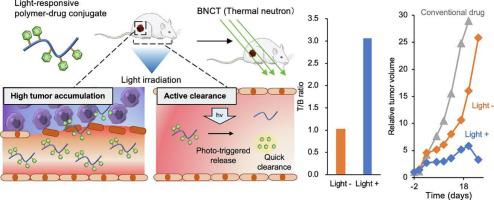当前位置:
X-MOL 学术
›
J. Control. Release
›
论文详情
Our official English website, www.x-mol.net, welcomes your feedback! (Note: you will need to create a separate account there.)
Active control of pharmacokinetics using light-responsive polymer-drug conjugates for boron neutron capture therapy
Journal of Controlled Release ( IF 10.5 ) Pub Date : 2024-06-08 , DOI: 10.1016/j.jconrel.2024.06.006 Daiki Tokura 1 , Kakeru Konarita 1 , Minoru Suzuki 2 , Keisuke Ogata 3 , Yuto Honda 4 , Yutaka Miura 3 , Nobuhiro Nishiyama 4 , Takahiro Nomoto 5
Journal of Controlled Release ( IF 10.5 ) Pub Date : 2024-06-08 , DOI: 10.1016/j.jconrel.2024.06.006 Daiki Tokura 1 , Kakeru Konarita 1 , Minoru Suzuki 2 , Keisuke Ogata 3 , Yuto Honda 4 , Yutaka Miura 3 , Nobuhiro Nishiyama 4 , Takahiro Nomoto 5
Affiliation

|
In boron neutron capture therapy (BNCT), boron drugs should exhibit high intratumoral boron concentrations during neutron irradiation, while being cleared from the blood and normal organs. However, it is usually challenging to achieve such tumor accumulation and quick clearance simultaneously in a temporally controlled manner. Here, we developed a polymer-drug conjugate that can actively control the clearance of the drugs from the blood. This polymer-drug conjugate is based on a biocompatible polymer that passively accumulates in tumors. Its side chains were conjugated with the low-molecular-weight boron drugs, which are immediately excreted by the kidneys, via photolabile linkers. In a murine subcutaneous tumor model, the polymer-drug conjugate could accumulate in the tumor with the high boron concentration ratio of the tumor to the surrounding normal tissue (∼10) after intravenous injection while a considerable amount remained in the bloodstream as well. Photoirradiation to blood vessels through the skin surface cleaved the linker to release the boron drug in the blood, allowing for its rapid clearance from the bloodstream. Meanwhile, the boron concentration in the tumor which was not photoirradiated could be maintained high, permitting strong BNCT effects. In clinical BNCT, the dose of thermal neutrons to solid tumors is determined by the maximum radiation exposure to normal organs. Thus, our polymer-drug conjugate may enable us to increase the therapeutic radiation dose to tumors in such a practical situation.
中文翻译:

使用光响应聚合物-药物缀合物主动控制硼中子捕获疗法的药代动力学
在硼中子俘获疗法(BNCT)中,硼药物在中子照射期间应表现出高瘤内硼浓度,同时从血液和正常器官中清除。然而,以时间控制的方式同时实现这种肿瘤积累和快速清除通常具有挑战性。在这里,我们开发了一种聚合物药物缀合物,可以主动控制药物从血液中的清除。这种聚合物-药物缀合物基于在肿瘤中被动积累的生物相容性聚合物。其侧链与低分子量硼药物结合,通过对光不稳定的连接体立即由肾脏排泄。在小鼠皮下肿瘤模型中,静脉注射后,聚合物-药物缀合物可在肿瘤中积聚,肿瘤与周围正常组织的硼浓度比较高(~10),同时也有相当数量残留在血流中。通过皮肤表面对血管进行光照射,裂解连接体,将硼药物释放到血液中,使其从血流中快速清除。同时,未经光照射的肿瘤中的硼浓度可以保持较高水平,从而实现较强的BNCT效果。在临床BNCT中,热中子对实体瘤的剂量是由正常器官受到的最大辐射剂量决定的。因此,我们的聚合物-药物缀合物可以使我们在这种实际情况下增加对肿瘤的治疗辐射剂量。
更新日期:2024-06-08
中文翻译:

使用光响应聚合物-药物缀合物主动控制硼中子捕获疗法的药代动力学
在硼中子俘获疗法(BNCT)中,硼药物在中子照射期间应表现出高瘤内硼浓度,同时从血液和正常器官中清除。然而,以时间控制的方式同时实现这种肿瘤积累和快速清除通常具有挑战性。在这里,我们开发了一种聚合物药物缀合物,可以主动控制药物从血液中的清除。这种聚合物-药物缀合物基于在肿瘤中被动积累的生物相容性聚合物。其侧链与低分子量硼药物结合,通过对光不稳定的连接体立即由肾脏排泄。在小鼠皮下肿瘤模型中,静脉注射后,聚合物-药物缀合物可在肿瘤中积聚,肿瘤与周围正常组织的硼浓度比较高(~10),同时也有相当数量残留在血流中。通过皮肤表面对血管进行光照射,裂解连接体,将硼药物释放到血液中,使其从血流中快速清除。同时,未经光照射的肿瘤中的硼浓度可以保持较高水平,从而实现较强的BNCT效果。在临床BNCT中,热中子对实体瘤的剂量是由正常器官受到的最大辐射剂量决定的。因此,我们的聚合物-药物缀合物可以使我们在这种实际情况下增加对肿瘤的治疗辐射剂量。
















































 京公网安备 11010802027423号
京公网安备 11010802027423号